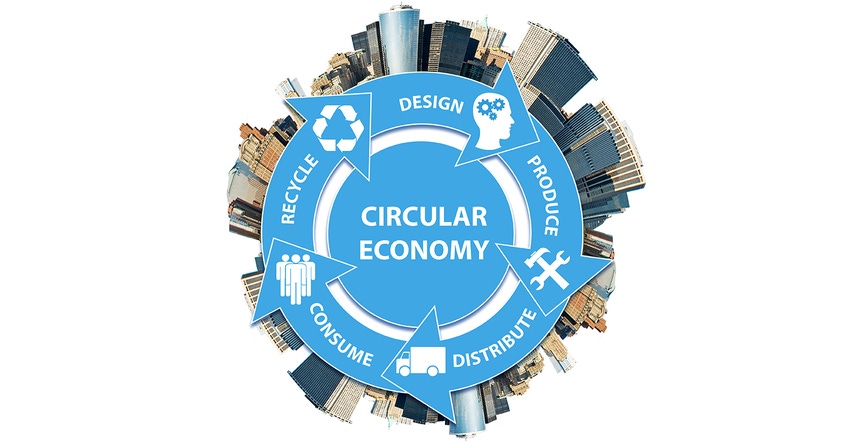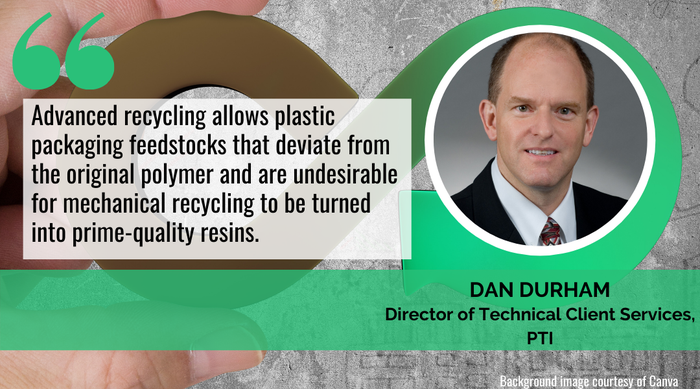Mechanical recycling can only take us so far, so we must look at advanced recycling methods to meet environmental objectives. However, the road is rocky.
June 23, 2021

We want packaging to protect, keep consumers safe, and make good use of material resources. We want to use barriers that reduce permeation of gases (carbon dioxide and oxygen) and moisture for products that are sensitive. We want to use colors and UV inhibitors the protect against the loss of vitamins and flavor. We might even want to brighten our package a bit.
Then we want our packaging back. Recycling efforts cannot be considered successful until we get the containers, bottles, pouches, etc., returned — and that continues to be a challenge, particularly in the United States.
But what do we do with it once we get it back?
The existing mode of attack is mechanical recycling. The process separates materials based on type: glass, metal, paper, and plastics. Today, it is relatively easy to set up a mechanical recycling plant and reclaim many materials for next generation use.
However, with plastics, mechanical recycling can only take us so far. The feedstocks cannot deviate far from the original polymer. Those materials we add to enhance package performance — such as nylon, color, oxygen scavengers — can negatively impact processing and appearance of mechanically-recycled polymers.

That takes us to the next level. To get circularity to work for packaging, we need to have chemical/advanced recycling technologies that work and are economical. Advanced recycling allows plastic packaging feedstocks that deviate from the original polymer and are undesirable for mechanical recycling, to be turned into prime quality resins.
There are three main advanced recycling areas, each offering a different level of polymer breakdown and, in theory, a different level of purity required of the feedstocks:
Purification. Plastics are dissolved in a solvent specifically targeted for the polymer to be reclaimed. The pure target polymer is extracted and contaminates such as additives, colorants, barrier material can be filtered and removed. The result is a pure polymer that can be reused. Technologies focusing on polypropylene and polystyrene are currently in use. The feedstock can have more contaminants than what mechanical recycling can handle, but ideally contain mostly the target polymer, with limited contaminants.
Decomposition. Plastics are broken down to their monomers and intermediates and the process allows the contaminants to be removed. These monomers and intermediates can be used to produce new polymer. Several technologies exist focusing on PET. The feedstock can have more contaminants than mechanical recycling and purification technologies.
Conversion. Plastics are broken down further than in decomposition and the output is hydrocarbons that can be used as raw materials for creating new monomers, intermediates, and polymers. These raw materials do not necessarily have be used to create the same polymer from which they came and can utilize a much broader polymer feedstock than purification and decomposition.
Why are we not getting what we want?
These technologies come with challenges that take time to overcome. According to Closed Loop Partnership, “of the 60 technology providers they surveyed, it has taken, on average, 17 years to reach growth scale. Further, more mature companies are typically those that produce fuels and petrochemicals from plastic waste. Those that produce polymers are at an earlier stage, on average.”
Scaling up to production is difficult. Most of these technologies start with a hypothesis and 10 grams of material in a benchtop beaker in a lab. Transforming that idea to an industrial plant capable of producing thousands of pounds per hour takes a tremendous amount of scientific, engineering, and financial resources — and time.
If we want our plastic back, we need to encourage, support, and invest in programs to drive these technologies, and use the materials produced to drive demand.
Dan Durham is the director of technical client services at PTI. He has decades of experience in plastic packaging ranging from design to injection and blow molding processing. He currently focuses his efforts on helping multinational brand owners successfully navigate packaging projects from concept to commercialization and supporting their sustainability goals.
PTI is recognized worldwide as a major source for preform and package design, package development, rapid prototyping, pre-production prototyping, and material evaluation engineering for the plastic packaging industry. For more information: www.pti-usa.com.
About the Author(s)
You May Also Like




